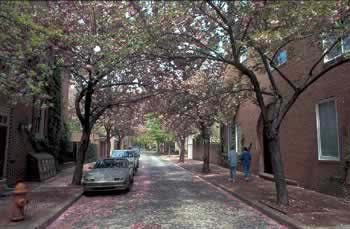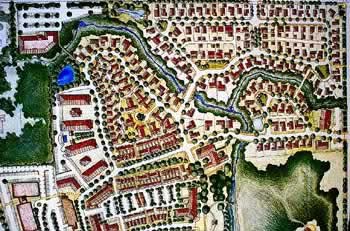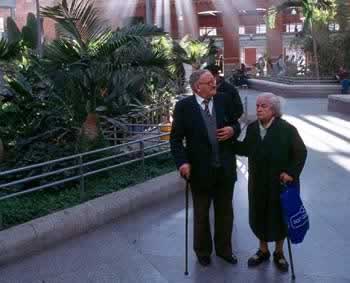|
How Can I Find and Help Build
a Walkable Community - continued
 |
5. Key Streets Are Speed Controlled.
Traffic moves on main street and in neighborhoods at
safe, pleasant, courteous speeds. Most streets are designed
to keep speeds low. Many of these streets are tree lined,
have on-street parking and use other methods that are
affordable means to keep traffic speeds under control.
There is an absence of one-way couplets designed to
flush downtown of its traffic in a rush or flight to
the suburbs. In most parts of the nation the streets
are also green, or have other pleasant landscaping schemes
in dry climates. |
|
| |
6. Streets, Trails are Well Linked.
The town has good block form, often in a grid or other
highly connected pattern. Although hilly terrain calls
for slightly different patterns, the linkages are still
frequent. Some of the newer neighborhoods that were
built to cul-de-sac or other fractured patterns are
now being repaired for walking by putting in trail connectors
in many places. These links are well designed so that
there are many eyes on these places. Code for new streets
no longer permits long streets that are disconnected. |
|
|
| |
| 7. Design is Properly Scaled to
1/8th, 1/4 and 1/2 mile radius segments. From most homes
it is possible to get to most services in ¼ mile
(actual walked distance). Neighborhood elementary schools
are within a ¼ mile walking radius of most homes,
while high schools are accessible to most children (1
mile radius). Most important features (parks) are within
1/8th mile, and a good, well designed place to wait
for a high frequency (10-20 minutes) bus is within ¼
to ½ mile. Note that most of these details can
be seen on a good local planning map, and even many
can be downloaded from the web.
|
 |
|
| |
 |
8. Town is Designed for People.
Look for clues that decisions are being made for people
first, cars second. Does the town have a lot of open
parking lots downtown? Are a lot of streets plagued
with multiple commercial driveways, limited on-street
parking, fast turning radii on corners. Towns designed
for people have many investments being made in plazas,
parks, walkways ... rarely are they investing in decongesting
intersections on the far reaches of town. Towns designed
for people are tearing down old, non-historic dwellings,
shopping plazas and such and converting them to compact,
mixed use, mixed income properties. Ask to review the
past year of building permits by category. Much is told
about what percentage of construction that is infill
and independent small builder stock versus big builder
single price range housing or retail stock. |
|
Previous | 1
| 2 | 3 |
4 | 5 | 6
| Next
|
Walkable
Communities.,
33 E. Pine Street, Orlando, FL 32801 (866) 347-2734
For any comments, questions or suggestions about the content of
this web site please email: Ken Owens
Last Updated:
April 22, 2005
|
|



